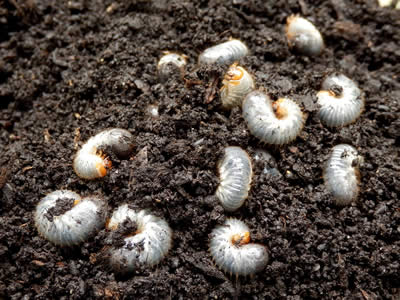Lawn Insects and Pests
Perhaps nothing is more frustrating than having grubs eat away at the lawn that you take such good care of all year long. Grubs are actually larvae of beetles that feed on grass roots usually during spring and fall.
Identification
There are a few telltale symptoms of a grub problem. You will see irregular patches seem to form in certain parts of the lawn, and these areas can almost be rolled up as sod since the roots have been severed. You may also notice moles or skunks digging in the yard, since these rodents actually feed on the grubs.
Control
It is most effective to control grubs during mid summer, when the beetles are laying their eggs since the eggs are most easily killed by grub control chemicals. You can also try to control them in the spring and fall, but the more mature grubs will be more resistant to the chemical.
Grubs are also sensitive to environmental factors. Summers that are very dry often result in reduced insect pressure the following fall and spring.

Life Cycle
It is important to understand the life cycle of these insects. Japanese beetles Lay their eggs in the soil in July, which hatch and begin to feed and grow as grubs into the fall. Prior to the onset of winter, they stop feeding and burrow deep into the soil where they remain until Spring. They resume feeding in spring and emerge as pupae in June where they feed on trees and shrubs while mating.
Repair
Areas damaged by grubs can be mitigated by irrigation and by overseeding in the fall. Irrigation helps the plants that are affected by providing water to the shallow, damaged roots. If you typically have grub problems each year, you may want to start applying a grub control chemical in late July.
